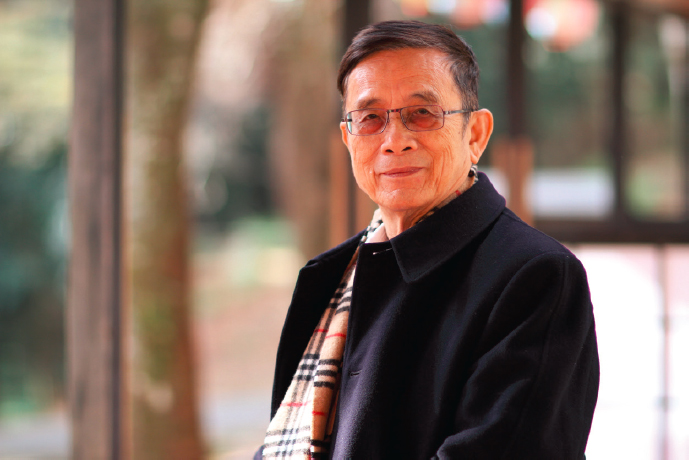CHUN-YEN CHANG
1937–2018
Elected in 2000
“For contributions to Taiwanese electronics industry, education, and materials technology.”
BY MIN-CHIUAN WANG
SUBMITTED BY THE NAE HOME SECRETARY
CHUN-YEN CHANG, who created Taiwan’s first integrated circuit and is known as the country’s semiconductor pioneer, died October 12, 2018, on his 81st birthday.
He was born October 12, 1937, in the Fengshan District of Kaohsiung, a city in southern Taiwan, during the Japanese occupation. His father, Mu-Huo Chang, was a farmer who relied on his own efforts to become a teacher at Fengshan Elementary School and later at Kaohsiung Middle School; his mother, Shu-Yu Cheng, was the daughter of a rich family in Fengshan. Chun-Yen had five siblings.
The first 10 years of childhood were happy for Chun-Yen Chang. That changed in 1947 with the February 28th Incident in Taiwan. His father was arrested and, although lucky enough to be released, lost his position as a high school teacher. The Chang family moved to Gushan in Kaohsiung, where his father made a living selling timber. Later the family moved to Madou District in Tainan City, where Chun-Yen finished his schooling. Because of the war and political turmoil, the boy attended seven schools.
In May 1950, when Chun-Yen Chang was in the sixth grade, the Madou incident (an event of the “White Terror”) occurred, and his father was arrested again and put in jail; 4 months later, he was shot. At the age of 12, Chun-Yen accompanied his mother on a train to Taipei to collect his father’s ashes.
After that, the Chang family fell into abject poverty, relying on the mother’s strong will to bring up Chun-Yen and his five brothers and sisters.
Despite the dramatic changes in family circumstances, Chun-Yen Chang maintained excellent grades and entered Tainan First High School, one of the best high schools in southern Taiwan. He regarded Albert Einstein as an idol and encouraged himself with accounts of Einstein’s troubled early life. He was most interested in physics and wanted to study in the Department of Physics at National Taiwan University in Taipei. But because of the family’s difficulties and a desire to assist his mother in raising the family, he decided to study electrical engineering at Cheng Kung University near his home. He graduated in 1960.
He then entered the National Chiao Tung University (NCTU) in Hsinchu and studied at the Institute of Electronic Engineering, obtaining a master’s degree in 1962. After graduating, he briefly worked for General Instruments, a US manufacturer, until the company wanted to send him to the United States for an internship; his application to the government to go abroad was rejected. Only then did he realize that his status as a family member of a political victim made it impossible for him to study abroad. Fortunately, under the assurance of NCTU president Si-Mou Li, he returned to his alma mater to work as a lecturer.
Within a few years he established Taiwan’s first Semiconductor Research Center at NCTU and served as its first director. Also in 1965, the university’s transistor research team successfully built the first bipolar transistor in Taiwan. In 1970, after he had been promoted to full professor, Chun-Yen Chang passed the oral examination of the doctoral dissertation by the Ministry of Education and became the first engineering PhD in Taiwan. He transferred to National Cheng Kung University in Tainan in 1977.
In the 1970s Professor Chang’s masterpiece was research on the charge conduction mechanism of a metal-semiconductor junction. In the 1980s he published an innovative process for using triethylgallium to grow gallium arsenide
in a low-pressure metalorganic chemical vapor deposition system. He was also committed to the development of new semiconductor components.
In 1988 Professor Chang transferred his research base back to National Chiao Tung University. After that, in addition to continuing the development of III-V material and devices, he initiated three new research areas: development of silicon germanium semiconductor compound technology, thin-film transistors, and development of innovative metal-oxide-semiconductor field-effect transistor devices.
Professor Chang became NCTU president in 1998 and served in that position for 8 years. During his tenure he doubled the university’s research funding, and NCTU was selected by the Ministry of Education as one of the country’s key research universities.
He promoted the National Si-Soft [silicon software] Project in 2001 to push for the transformation of Taiwan’s semiconductor industry from manufacturing to design services. The project nurtured many integrated circuit design talents, allowing the semiconductor industry to support the vigorous development of the information and communications technology industry.
After retiring, Professor Chang returned to research and led graduate students to study new inventions of various semiconductor components, devoting the most in-depth attention to the negative capacitance transistor and cladding-type gate electrode 200 without a junction transistor.
As a family member of the victims of the White Terror, Chun-Yen Chang was hindered in his early education and employment. But with his tireless efforts and strategic initiatives, he became the first national PhD of engineering in Taiwan and internationally recognized for his outstanding work, with election in 2000 as a foreign member of the US National Academy of Engineering. During his commendable career he promoted the establishment of the first national semiconductor research center to drive the development of Taiwan’s semiconductor industry and cultivated leaders of that industry.
Professor Chang is survived by his wife, Shen-Mei Li; sons Wei-Heng, Wei-Ren, and Wei-Lun; and many grandchildren.





